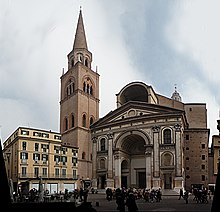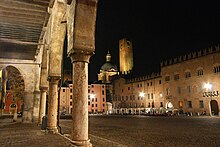 | ||
| Mantua | ||
| region | Lombardy | |
|---|---|---|
| Residents | 49.409 (2018) | |
| height | 19 m | |
| no tourist info on Wikidata: | ||
| location | ||
| ||
Mantua is a city in the Lombardy and capital of the province of the same name.
background

Mantua was founded at the time of the Etruscans who the city Manthva named, possibly derived from Mantus, the Etruscan god of the underworld, or from the Greek seer Manto. The Roman poet Virgil was born in 70 BC. Born near Mantua. Mantua has been a bishopric since 804. In the course of history it was ruled by different noble families, whose representative buildings are still visible in the cityscape today. Mantua is surrounded by several lakes that were created in the 12th century. These lakes get their water from the river Minciowho at Peschiera del Garda from the Garda lake flows.
From 1328 the Gonzaga family ruled, who over time became margraves and finally dukes of Mantua. In the late 15th and 16th centuries they were among the most powerful royal houses in Italy and were generous patrons of the arts. At their court were z. B. the architect Leon Battista Alberti, the painter Andrea Mantegna and the composer Claudio Monteverdi. During this time - the Renaissance and the early Baroque - there was also a major redesign of the townscape. When the main Gonzaga line died out in 1627, the War of the Mantuan Succession broke out between France and the Habsburgs. The French were able to enforce their favorites. During the War of the Spanish Succession, his descendants were deposed in 1708 and the Habsburgs themselves took over direct rule.
At the time of Napoleon, Mantua was under French rule from 1805 to 1814. The leader of the Tyrolean popular uprising, Andreas Hofer, was brought to Mantua in 1810 and executed in the citadel. That is why the city is prominently mentioned in the Tyrolean national anthem, the Andreas Hofer song ("At Mantua in gangs the loyal Hofer was"). In the opera world, the city is through Verdi's opera Rigoletto known that takes place in Mantua. The Duke of Mantua plays one of the main roles in it and sings the famous canzone La donna è mobile (“Oh, how deceptive are women's hearts”).
In 2008 the old town of Mantua became the UNESCO world cultural heritage appointed, jointly with the neighboring city Sabbionetawhose city map was designed strictly geometrically. Mantua was named “Capital of Italian Culture” in 2016.
getting there

By plane
The closest airports are the Verona airport(IATA: VRN); 35 km away), Bologna Airport(IATA: BLQ); 105 km) and Bergamo Airport(IATA: BGY); 120 km). There are no fast and convenient connections by public transport from any of the airports, so a rental car is an option.
By train
The 1 Mantua train station can be reached every hour with regional trains Verona (Journey time 45 minutes), every two hours Cremona (45 min) and Milan (1: 50–2 hours) and Legnago (1 hour) and Monselice (1:45 hours). Coming from Germany and Austria, you can change trains in Verona (total travel time from Munich 6:45 hours, from Innsbruck just under 5 hours, from Bolzano 2:45 hours). From Switzerland you drive via Milan (e.g. 6 hours from Zurich).
By bus
Out Peschiera del Garda buses run six times a day APAM- Line 46, the journey takes a little over an hour.
In the street
Mantua is not far from the ![]() Brenner motorway between Verona (45 km) and Modena (77 km). Free parking with shuttle bus in front of the city.
Brenner motorway between Verona (45 km) and Modena (77 km). Free parking with shuttle bus in front of the city.
By boat
mobility
Tourist Attractions
Churches

- 1 Basilica of Sant'Andrea (basilica di Sant'Andrea), Piazza Andrea Mantegna. Designed by Leon Battista Alberti and built from 1472 onwards, it is considered one of the most outstanding works of the Italian Renaissance. The Gothic bell tower (campanile) is a remnant of the previous building, a Benedictine monastery from the 11th century. The baroque dome designed by Filippo Juvarra was added in 1732. Inside, the grave chapel of the painter Andrea Mantegna, which Antonio da Correggio painted with frescoes, is particularly noteworthy. Mantegna's paintings are also here Holy Family and Family of John the Baptist as Baptism of christ to see. Members of the Mantuan dynasty are buried in the crypt.

- 2 Dom (duomo di Mantova). Catholic Episcopal Church. A church stood at this point in early Christian times. It was rebuilt around 1100 in the Romanesque style and substantially expanded around 1400, with the magnificent marble facade with a covered portal, rose windows and pinnacles. After a fire, the cathedral was rebuilt in 1545 under the direction of Giulio Romano, with the interior being significantly redesigned in the Mannerist style. Today's classicist marble facade was designed in 1756–61.
- 3 Rotonda di San Lorenzo. The striking Romanesque rotunda was built in the 11th century during the rule of Margravine Mathilde von Canossa. Presumably there was a round temple in the same place as early as in antiquity. The Rotonda was used as a church until 1579, then as a storage room and fell into disrepair. 1908–1911 it was reconstructed and today serves again as the parish church of the Dominican Order. The remains of some medieval frescoes can still be seen inside.
- 4 Basilica palatina di Santa Barbara, Piazza Santa Barbara, 2. Court church of the dukes, built 1562–72 at the transition from the Renaissance to the early Baroque style.
Castles, chateaux and palaces

- 5 Palazzo Ducale, piazza Sordello, 40 - Mantova. Tel.: 39 0376 35 21 00, Fax: 39 0376 36 62 74, Email: [email protected]. Palace built in the 14th to 17th centuries. It served as the seat of the Gonzaga family, who ruled Mantua and the surrounding area first as counts and later as dukes. With an area of 34,000 square meters, 500 rooms, seven gardens and eight inner courtyards, it is one of the most extensive palace complexes in Europe.
- 6 Castello di San Giorgio. Medieval fortress from around 1400. The wedding room is particularly noteworthy (Camera degli Sposi) with valuable Renaissance frescoes by the artist Andrea Mantegna. Access to Camera degli Sposi is limited to a maximum of 1,500 entries per day and is permitted for groups of 25 people. The stay in the chamber is 5 minutes.
- 7 Palazzo del Te (Palazzo Te), Viale Te, 13. Tel.: 39 376 323266. Ducal pleasure palace from the early 16th century on the outskirts. It was designed by Giulio Romano and is kept in a Mannerist style, which clearly distinguishes it from the classic northern Italian Renaissance villas. Part of the palace houses that Museo Civico with Mesopotamian, ancient Egyptian and numismatic collections as well as impressionist paintings by Federico Zandomeneghi and Armando Spadini.
Buildings
- 8 Palazzo della Ragione. The Broletto served from the 13th century as the central meeting place for the citizens of Mantua, as a town hall, court square and market hall. The clock tower (Torre dell'Orologio) with astronomical clock was added in the 15th century.
Monuments
- 9 Andreas Hofer monument. Andreas Hofer was the leader of the Tyrolean popular uprising, he was executed in Mantua in 1810.
Streets and squares

- 10 Piazza Virgiliana
- 11 Piazza Sordello
Museums
- 12 Museo Diocesano Francesco Gonzaga. Paintings and sculptures, especially from the 15th to 17th centuries, as well as works by Giuseppe Bazzani; Treasury of the cathedral, coins, weapons, tapestries, ceramics.
activities
shop
kitchen
nightlife
accommodation
- 1 Hotel ABC, Piazza Don Eugenio Leoni, 25-27. Tel.: 39 376 322329.
- 2 Hotel Rigoletto, Piazza Don Eugenio Leoni, 17. Tel.: 39 376 355080.
- 3 Hotel Italia, Piazza Felice Cavallotti, 8. Tel.: 39 376 322609.
- 4 Hotel Casa Poli, Corso Garibaldi 32, Mantua. Tel.: 39 376.288170, Fax: 39 376.362766. Elegant atmosphere, minimalist design and quality service: a luxury stay in the heart of Mantua.
Learn
Work
security
health
Practical advice
- Official Mantua Tourism Site also in German
- Free WI-FI service in several places in the old town: in the network of Mantova free WI-FI log in with the mobile phone number. Information is also available on the city's tourism page.
trips
.jpg/220px-Viale_delle_Rose_(58).jpg)

- 13 Santuario della Beata Vergine delle Grazie, Grace, Curtatone (9 km west of Mantua, slightly off the SP 10 towards Rodigo / Cremona / Brescia). Gothic St. Mary's Church from around 1200 with valuable frescoes. Several members of the ruling family of Mantua are buried here. What is curious is an embalmed crocodile from the 15th or 16th century that hangs from the ceiling of the nave.
- The Mincio Regional Park is a protected landscape area of almost 16,000 hectares that stretches along the course of the Mincio from Lake Garda to the mouth of the Po, i. H. both northwest and southeast of Mantua. Here you can observe numerous species of water birds and birds of prey, e. B. kingfisher, white stork, silver, cow and tail heron, pond rail, bee eater, black kite, peregrine falcon. A 43.5 km long cycle path leads from Mantua along the Mincio Peschiera del Garda.
- 14 Parco Giardino Sigurtà, Valeggio sul Mincio (28 km north; on the SR 249 towards Peschiera del Garda). The landscape garden was named one of the most beautiful gardens in Italy.
- Only 1 km from the garden is the village 15 Borghetto, which is one of the most beautiful villages in Italy, as well as the 16 Ponte Visconteo, a striking medieval dam and bridge structure with fortress character from the late 14th century.
- Verona (45 km northeast) -
- Parma (62 km southwest)
- Reggio nell’Emilia (62 km south)
- Cremona (67 km west)
literature
Web links
- http://www.comune.mantova.gov.it/ - Official website of Mantua
















,_view_from_the_Visconti_bridge2.JPG/350px-Borghetto_(Valeggio_sul_Mincio),_view_from_the_Visconti_bridge2.JPG)
